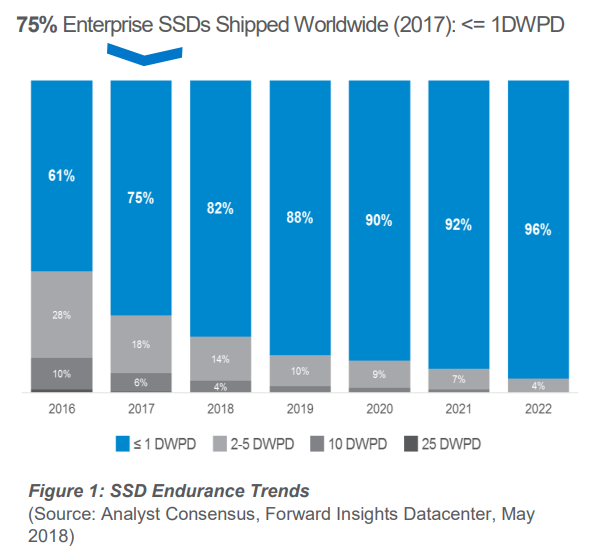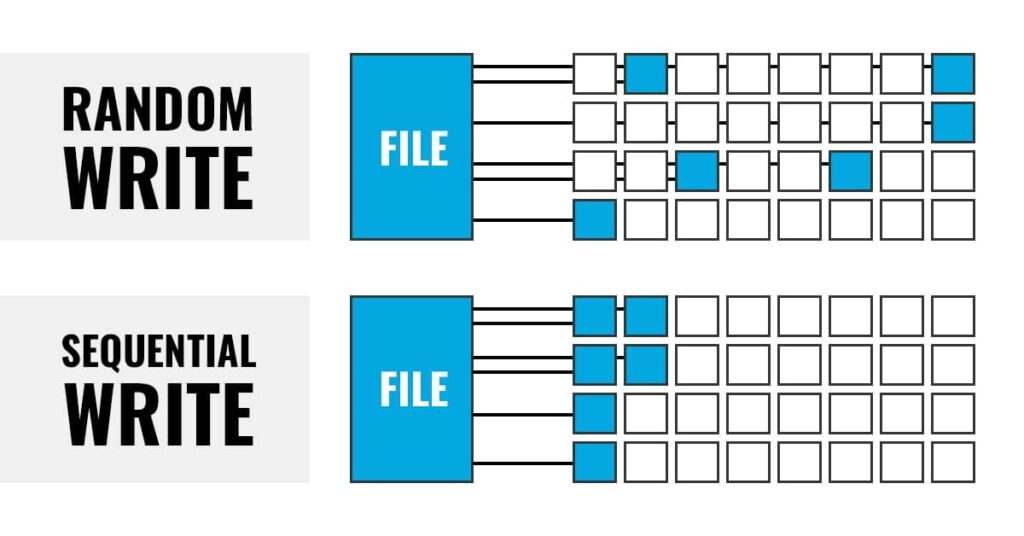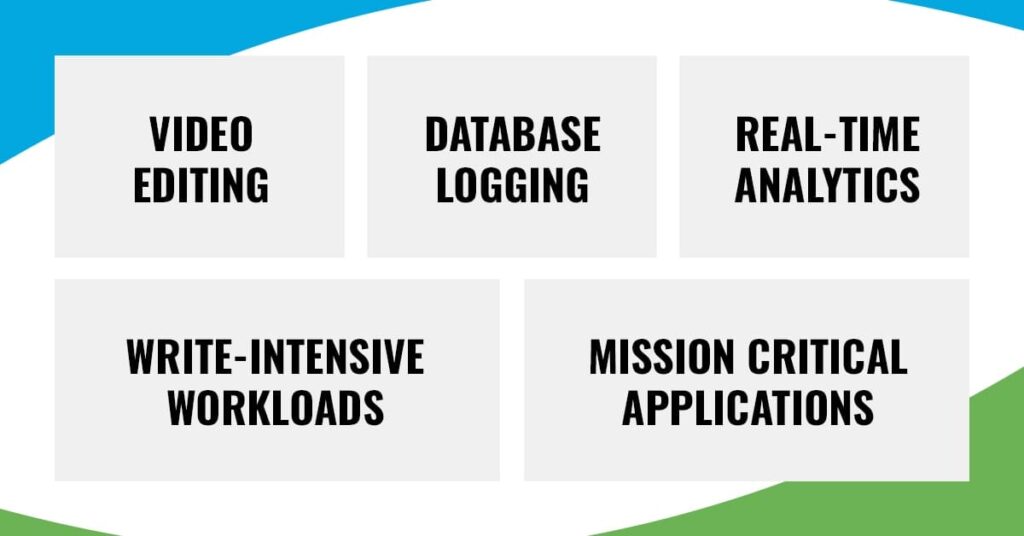Drive rewritability is important, but it matters more for some workloads than others. Understanding how drive endurance is measured can help you select drives which best meet your data center needs.
In the intricate landscape of data center management, selecting the appropriate storage drives is pivotal. Those procuring drives must consider cost, speed, and, of course, endurance. Here, comparison between HDDs and SSDs is far from straightforward. Rather, it hinges on nuanced factors such as endurance ratings and workload I/O type. It all depends on the specific drive and what you do with it. For instance, archiving data is different from updating databases or training on datasets. Each task has its own needs.
A key aspect of the selection process is knowing when drive rewritability is or isn’t essential. This helps you identify drives that perform well in a given scenario. This guide looks at how drive endurance is measured, and how much these measures matter. Choosing wisely can avoid unnecessary costs and ensure optimal performance.
The Physics of Drive Rewritability
For HDDs, data storage involves altering magnetic polarization on magnetized surfaces. This doesn’t directly wear out the magnetized platter. However, HDDs are prone to mechanical failures due to the delicate nature of the small, fast-moving read/write spindle. Since both reading and writing processes involve the spindle physically moving to the relevant place in the drive, an HDD wears out irrespective of whether you write or just read.
SSDs predominantly use NAND flash. Data is stored as charges in cells, each made of one or more transistor. Erasing data in a NAND cell leads to electron movement through an insulator and back, causing the insulator to wear over time. SSD types like MLC, TLC, and QLC wear out faster due to having more charge thresholds per cell. Although 3D NAND SSDs are denser and more durable, their production costs are higher. Many SSDs are specialized for specific types of I/O, like write-intensive, read-intensive, or mixed-use.

Related Reading
While pricy and difficult to fabricate, 3D NAND allows for both density and durability.
Long story short: SSDs wear during data writing, whereas HDDs experience wear during both writing and reading operations. While failure rates for different drives may appear similar in the first three years, after four years, HDD failure rates increase notably, while SSDs typically maintain an Annualized Failure Rate (AFR) of 1% or less.
How Is Drive Rewritability Measured?
Since flash cells wear out over time, the adoption of SSDs saw the advent of warranties based on write endurance limits. At that time, HDDs instead had time-based warranties, which are still common. However, disk drive manufacturers have since taken a leaf out of the flash playbook, and now more widely publish read/write endurance ratings.
Commonly Used Endurance Ratings:
- TBW (Total Bytes Written): TBW measures the total amount of data one can write to an SSD over its lifespan.
- DWPD (Drive Writes Per Day): DWPD represents the number of times you can write the entire capacity of an SSD every day over the course of its warranty period without exceeding its expected lifespan.
- AWR (Annualized Workload Rate): The number of reads and writes an HDD can perform in a year. Also known as workload limit rating.
- DRWPD (Drive Read/Writes Per Day): While less common, this measures HDD endurance, as both the read and write process incur wear.
Converting Endurance Ratings:
You can obtain the DWPD of your flash drive from TBW by:
DWPD = TBW / [(drive capacity) * (warranty period in days)]
Annualized workload rates of an HDD are calculated as follows. (Note that 8670 is the number of hours in a year, and “total” means the whole lifetime of a drive.)
AWR=(Total writes + Total reads)*(8670/Total Power-On Hours)
Finally, the DRWPD of a Hard Drive is as follows:
DRWPD=(AWR/365)/Capacity
Measuring Different Media
For HDDs, evaluation of annualized workload rates involves measuring both write and read operations, because the read process in an HDD can also wear out the drive. DRWPD indicates the number of times you can read/write the entire capacity of the drive every day over the course of its warranty period without exceeding its expected lifespan.
When SSDs first arrived, it was tough for people to figure out how long they would last. This led many storage planners to deploy SSDs with endurance ratings far in excess of what they actually needed. Over time, though, as drives got bigger and people learned more about how they’re used, the number of writes per day (DWPD) needed went down. This trend is illustrated in the figure below.

Age of QLC SSDs
So how should you compare the DWPD of an SSD with the DRWPD of an HDD? You shouldn’t! According to a Micron whitepaper, the DWPD of an SSD varies depending on the type of write I/O, while DRWPD of an HDD doesn’t. So while metrics are important, choosing the right drive involves more than just numbers: it depends on what the drive will be used for.
Sequential Writes Vs Random Writes
A crucial aspect in evaluating drive performance is distinguishing between sequential and random writes. Sequential writes involve writing files on adjacent blocks in order, which is typically more quick and efficient. Both SSDs and HDDs can handle sequential writes.
On the other hand, random writes involve spreading data across the drive in different locations, leading to slower write speeds due to the controller needing to manage more addresses. HDDs generally do not perform well with random writes due to the limitations of their mechanical components. The required spindle movements make random writes prohibitively slow on HDDs.

While random writes are more feasible on SSDs, it also involves a more complicated ‘garbage collection’ process since the SSD controller may need to perform additional operations to reclaim space and consolidate valid data scattered across different physical locations.
The sequential/random distinction complicates comparisons of drive performance. The type of write I/O heavily influences DWPD. Drives with a high proportion of small and random writes tend to have lower DWPD, while those with a more large and sequential writes typically exhibit higher DWPD. The key is to understand what type of I/O is in play when selecting drives for a particular application.
Don’t be fooled by the raw numbers. High DWPD drives aren’t automatically preferable. Choose a drive based on your specific workload, considering both write patterns and volume.
When Does Read/Write Endurance Matter?
In data storage, not all workloads are equal. Write-intensive workloads and mission-critical applications are scenarios where endurance is paramount. Examples include database logging, video editing, and real-time analytics. In critical settings like hospital servers, sudden malfunctions can have severe consequences.

The type of write operation also plays a significant role. Random writes are used for tasks involving numerous small changes, like transaction logging, simultaneously downloading multiple files, or making database changes. Conversely, sequential writes excel in scenarios where speed is crucial, such as moving large files like videos.
However, there are also cases where endurance matters less:
- Backup drives, where constant rewriting is not a primary concern.
- Temporary storage, which doesn’t require long-term reliability.
- Archives that are predominantly read-only or infrequently modified, as they endure fewer write cycles compared to active storage systems.
The key is to understand the specific workload requirements when selecting drives for a particular application.
Controllers and Write Amplification
The SSD controller affects durability by determining how data is written to the drive. Given that writing gradually wears out NAND cells, careful thought and programming are required to manage data storage efficiently on flash drives. An analogy: if you imagine your SSD as a grassy field, then storing data is like strategically directing sheep to graze on specific patches. It’s crucial not to repeatedly direct different “sheep” (data) to the same patch of “grass” (NAND cells), as this can lead to premature wear.

Another important consideration is that SSDs write data in blocks, typically consisting of around 512 bytes, rather than modifying individual bits. When even a single byte within a block is altered, the entire block must be rewritten, leading to what’s known as ‘write amplification’. Write amplification is the ratio of media writes to host writes, often occurring when a single host command triggers multiple writes to the same data. This phenomenon can result in reduced performance, decreased endurance, and increased power consumption.
Since the controller process, rather than the NAND hardware itself, influences write amplification, enabling the TRIM command is one method to improve the write amplification factor (WAF). It’s preferable to maintain a WAF close to 1 for optimal performance and longevity of the drive.

Related Reading
A lot goes into making SSDs last. In addition to improvements to the physical design of flash cells, techniques such as wear leveling and error correction can help drives last.
Choosing A Drive: Things To Consider
It’s important not to automatically assume HDD is always better when it comes to drive rewritability. Sometimes SSDs are more durable than HDDs.
Take for instance a use case like network-attached storage (NAS) devices. NAS environments often involve multiple users accessing and transferring data simultaneously over a network. According to the folk at ServeTheHome: The WDWD201KFGX (Red Pro 20TB) NAS HDD has an annual workload rating of 300TB transferred, with a 5-year warranty period. With a bit of calculation, that comes out to 1500 TBW (5*300). On the other hand, the 4TB WD Red SA500 NAS SATA SSD is rated for 2500 TBW over five years. WD uses the same endurance metric for both HDD and SSD, which is what makes direct comparison possible.
In case of enterprise-grade drives, WD Gold 20TB HDD has a 550TB annual workload, offering 2750 TBW. The drive typically costs about $450-$650. Enterprise-grade SSDs, like WD’s Ultrastar DC SN840 6.4TB, provide much higher durability, offering 35,000 TBW over five years. However, the latter comes at a significantly higher cost, typically exceeding $1000.
As always, cost remains a primary consideration between HDDs and SSDs. Factors such as discounts, warranties, etc. may also make a difference.
Knowing Your Needs
Determining the ideal storage drive for your data center demands careful consideration of several factors. While HDDs have traditionally been synonymous with rewritability, SSDs are increasingly challenging this notion, especially in specific use cases. Nevertheless, cost remains a significant determinant, with HDDs retaining their appeal for mass storage. Whether this remains the case depends on the ability of innovations like HAMR to keep costs down and maintain competitiveness.
Ultimately, the decision of what drive to purchase hinges on understanding your data center’s unique requirements and selecting drives tailored to meet those needs.
Get in touch with Horizon Technology for expert support with all your data center storage needs.











